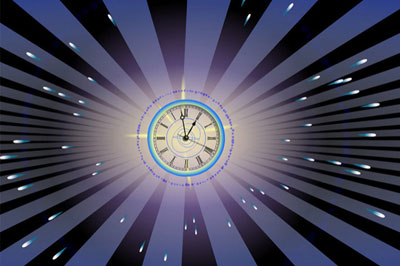 It’s part clock, part scale: A newly developed atomic clock measures time based on the mass of a single atom. The research, published online January 10 in Science, is controversial but could provide scientists with more precise methods of measuring both time and mass.
It’s part clock, part scale: A newly developed atomic clock measures time based on the mass of a single atom. The research, published online January 10 in Science, is controversial but could provide scientists with more precise methods of measuring both time and mass.
“This is the first clock based on a single particle,” says Holger Müller, a physicist at the University of California, Berkeley. “Its ticking rate is determined only by the particle’s mass.”
The idea for the clock stemmed from the quantum principle that particles also behave as waves, and vice versa. In particular, Müller and his colleagues wanted to determine how frequently the wave form of a single atom oscillates, a quantity that in quantum mechanics is inherently linked to the atom’s mass. Then the researchers could use those oscillations like swings of a pendulum to create a clock,according to Science News Magazine.
The snag in Müller’s plan was that it’s impossible to directly measure the oscillation frequency of waves of matter. The frequency of these waves is about 1025 hertz, 10 orders of magnitude higher than that of visible light waves. So Müller and his colleagues came up with an apparatus that creates two sets of waves — one based on a cesium atom at rest and another on the atom in motion. The researchers measured the frequency difference between the waves and then used that number, a manageable 100,000 hertz or so, to calculate the much larger oscillation frequency of cesium at rest.
With this approach, Müller was able to use the wave frequency of the cesium atom to create a clock that would gain or lose a second after eight years. That’s better than a wristwatch but about a hundred millionth as precise as today’s best atomic clocks, which count the frequency of light emissions from an atom as its electrons release small bursts of energy.
Physicists not involved with Müller’s research are impressed with his clever technique but are skeptical about its potential for precise timekeeping. “I think the paper is slightly oversold,” says Vladan Vuletić, a quantum physicist at MIT.
Other researchers have a more conceptual objection: Because there is nothing at this frequency actually oscillating within the atom, they say it is not a clock at all. “It may be a clock numerically, but it’s not a physical clock,” says Christian Bordé, a physicist at the Paris Observatory. Müller counters that the clock’s simplicity is its greatest trait: He is measuring an intrinsic quantum property of an atom, one that depends only on the atom’s mass.
In fact, this relationship between frequency and mass means Müller’s technique may prove most useful as a scale for measuring mass. Scientists define the kilogram, the base unit of mass, with a lump of metal stored in a French vault — a lump that is likely gaining heft from contamination (SN: 11/20/10, p. 12). The international General Conference on Weights and Measures, led by Bordé, wants to replace this artifact with a kilogram standard based on fundamental physical constants.
Müller says he can do just that by measuring the frequency of matter waves to accurately determine an atom’s mass. Once he finds the mass of one atom, he says, it is straightforward to relate it to the masses of other atoms. He will have a lot of convincing to do, but Müller plans to let the scientific process play out to test his ideas. “This is a concept that physicists never thought about,” he says. “This frequency wasn’t measurable until now.”
M.W

